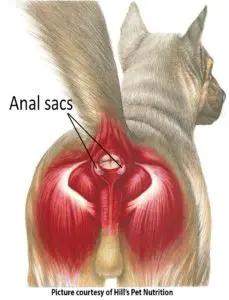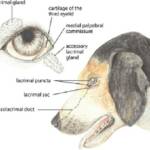We’ve all seen that awkward moment when your dog scoots their rear across your carpet. The most common reason is their anal glands were full. Humans have anal glands but so small that most people don’t even know they exist. But they are much larger and more prone to filling up and clogging in dogs and cats.
While anal glands getting full or becoming infected are not uncommon in veterinary medicine, these can be treated medically (most of the time) and are benign. In some instances, a more serious problem occurs and a glandular tumor called a adenocarcinoma can develop in the anal glands.

Before delving into anal gland tumors, here’s a quick review of normal anal glands. These structures are basically small bean sized glands that fill with a brown liquid notorious for its metallic, fishy smell. Dogs and cats have two anal glands that sit just inside their anus at the 4-5 and 7-8 o’clock positions.
When the dog defecates, some of the stinky fluid in these sacs is squeezed out with the feces. Why do they exists? The liquid may play a role in territorial marking between dogs an cats.
Anal sac tumors are cancerous growths in the anal sac. left untreated (not surgically removed and in some cases treated with radiation) they are generally fatal. They can affect any dog but older dogs and certain breeds such as spaniels, German Shepherds, and dachshunds are at higher risk. These tumors can also spread beyond the glad in a process known as metastasis.
In addition, the tumor can cause a disregulation of calcium metabolism in a process known as “hypercalcemia of malignancy.” These tumors cause discomfort, issues defecating, pain and a decreased quality of life to your dog. It is important to catch an address these tumors early and to treat them as soon as possible.
What causes anal gland tumors?

As with most cancers, a definitive cause has not been identified. However, genetics probably play an important role.
As the mass grows, the anal sac gets larger and can reach very impressive sizes that compresses the anus and makes defecation painful and difficult. Additionally, when cancer cells migrate to other parts of the body they make new metastatic tumors. Over time, they can also spread to essential organs, such as the lungs, liver and kidneys.
Back to hypercalemia of malignancy. This is when factors in the cancerous mass cause elevated calcium in the bloodstream. High calcium can cause muscle tremors, cause voluminous urination, intestinal motility changes and heart rhythm abnormalities as well. Excess calcium can also bind with phosphorous to create tiny crystals that can lodge in the kidneys. Overall, this is very bad news!
Symptoms of anal sac tumors
It depends on the behavior of the tumor and where it has spread. Many dogs won’t show any signs early on. However, when the tumor spreads to nearby lymph nodes or the mass gets large, your dog may strain and struggle to defecate, or not even defecate at all. They can also have ribbon-like stool and swollen back legs.
When the tumor increases blood calcium levels, your dog may drink and urinate more (from elevated calcium), eat less, vomit and seem weak and tired.
Other possible signs include:
- Swelling at the rear end
- Licking the rear end more than usual
- Bleeding around the anus
- Bloody stool
Dogs with anal sac tumors may also scoot, meaning they sit and drag their rear end against the ground. However, scooting much more commonly indicates full or inflamed anal glands that need to be expressed (squeezed) by your veterinarian, rather than cancer.
The best way to catch anal gland tumors early, is at the first sign of scooting or licking, ask your veterinarian to check them. A simple rectal exam can diagnosed gland abnormalities and a plan can be developed from there.
How are anal sac tumors diagnosed?
Your veterinarian will talk to you about the history of your dog’s problem as well as perform a physical exam. They will perform a rectal exam to feel for the tumor. During this procedure, they will stick a gloved finger into your dog’s anus. If they feel or see a growth, they might recommend sedation and do a fine needle aspiration of the mass.
This means they will poke the mass with a needle, get the cells to exfoliate and send it to a lab for evaluation by a clinical pathologist. If these results are suspicious for definitive of cancer, your veterinarian will likely surgically remove or refer you to a boarded surgeon to remove the mass and send it to a lab to confirm it is cancer.
Prior to surgery, chest x-rays will likely be recommended to ensure there is not obvious signs of having spread to the lungs. Additionally, your veterinarian will do blood and urine tests to check for high blood calcium and any other abnormalities.
In some cases, local LNs will also be sampled when your pet is sedated to ensure the cancer hasn’t spread.
Treating anal sac tumors treated
Until surgical treatment occurs (assuming you want to do this), your veterinarian may recommend stool softeners to make it easier for your dog to defecate The next step after chest x-rays, lab work and possible local LN samples is surgery. This may occur at your family veterinarian or you may be referred a boarded veterinary surgeon better quipped to remove these tumors without damaging the anal sphincter.
Surgery involves surgical removal of the mass and any enlarged lymph nodes in the area. Surgery has been shown to lengthen the survival time of dogs with anal sac tumors. However, tumors may eventually reappear if cancer cells are left behind and the cancer cells may have already spread to other sites at the time of removal.
Because anal sac tumors have such a high risk of spread, chemotherapy and /or radiation is often recommended after surgery. It involves giving medications, often via the mouth or blood, to kill or inhibit cancer cells throughout the body. radiation treatment is performed at a specialty hospital that has the proper equipment.
Both chemotherapy and radiation therapy can have serious side effects that your veterinarian will discuss with you.
Prognosis?

Survival times for dogs with anal sac tumors vary But every dog’s situation is different because prognosis depends on many factors such as:
- The size of the tumor at the time treatment is initiated
- Spread throughout the body
- Blood calcium levels
- Type of treatment
Dogs who receive surgery early on typically have a better prognosis than dogs that are treated after the tumor had grown larger and potentially spread.
How can I prevent anal sac tumors?
There’s no proven way to prevent anal sac tumors from developing. Early detection is important and may be achieved through routine rectal exams performed by your veterinarian.


